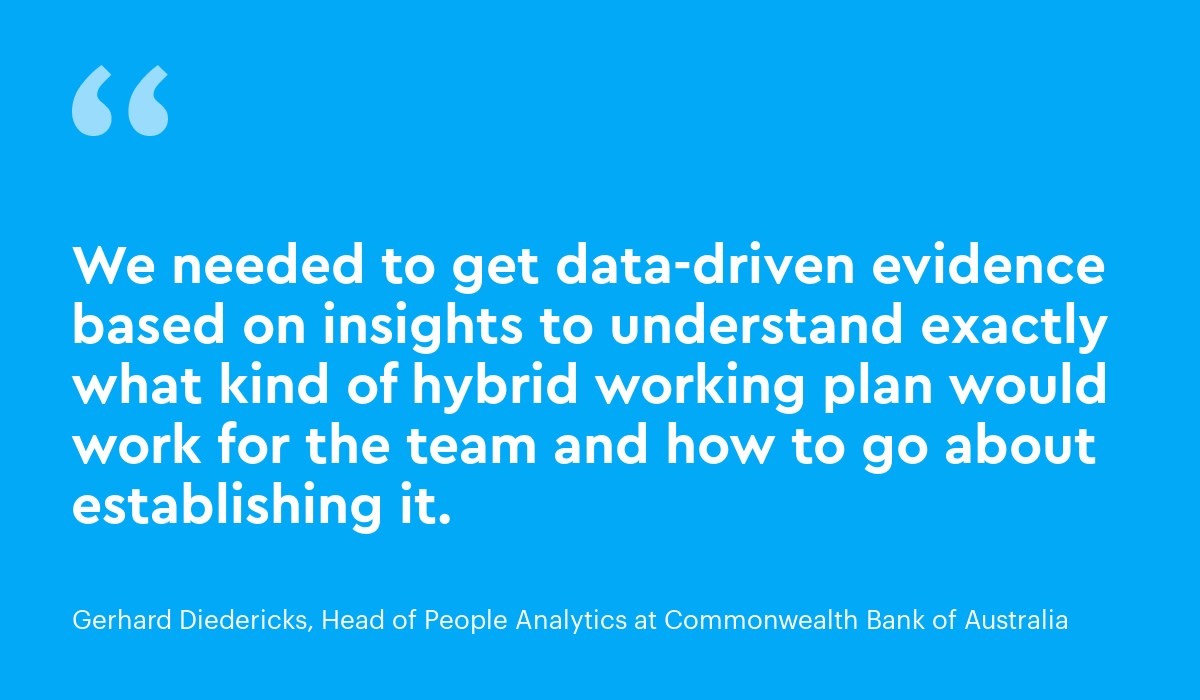Do You Really Understand the Impact of Your Return to the Office Policy?
Do you know how return to the office policies are impacting your employees? Learn how to use people analytics and HR data to find out.

According to Gallup research, 56% of full-time U.S. employees, representing more than 70 million people, say they can do their jobs from home. As of June, though, Gallup says that 20% were entirely onsite, 50% were hybrid, and 30% were exclusively working remotely.
Many organizations are contemplating the impact of their return to the office plans, and they’re searching for accurate insights to understand it.
Return to the office policies: A slippery slope
Some companies have taken a hard line approach to their return to office (RTO) plans, requiring everyone to come back to the physical workplace—and some have since backpedaled to allow more flexibility. Many organizations are taking a logical and thoughtful approach, evaluating what makes sense given employee job requirements and collaboration pathways.
According to a recent Zapier survey, 32% of U.S. employees say they’ve already quit a job because they didn’t have the option to work remotely. Many business leaders are trying to strike the right balance between working in the office and from home as part of their return to the office policies—but they’re flying blind.
And, once they’ve asked employees to return to the office, they’re left with even more questions:
Are employees showing up?
How long are they staying?
Is tardiness and absenteeism on the rise?
If they require employees to return to work, will there be a negative effect on engagement and productivity?
Will turnover increase?
The truth is most companies don’t know, and they can’t predict what the impacts and implications will be. Organizations and people leaders need to know what’s working—and what’s not. Data makes all the difference when it comes to accurately answering these questions.
Using data to optimize return to the office policies
As Commonwealth Bank of Australia began considering return to the office options, they had a number of questions:
To what degree do different hybrid working patterns impact productivity within teams?
Are those working from home more or less engaged than those predominantly working from the office?
To what degree does working from home impact our ability to connect with colleagues and to collaborate on interesting projects?
What health and wellbeing challenges do we need to be aware of?

Commonwealth Bank needed to understand whether their return to the office plans were working, and what exactly was working. They partnered with Visier’s custom solutions team to gain insights using employee badge scan data. Their employees have badges which allow them entry into the office. They used badge scans to tie attendance data to their existing people data so they could know:
Who was entering the building
How long employees were staying in the building
The most popular days of attendance
The average hours worked
By combining badge scan data with their existing HR data, they were able to further break it down to look at certain populations—like caregivers with young children, for instance—to see if they had different working patterns from other groups.
“We needed to get data-driven evidence based on insights to understand exactly what kind of hybrid working plan would work for the team and how to go about establishing it,” says Gerhard Diedericks, Head of People Analytics at Commonwealth Bank. It was important, he says, to answer questions related to productivity, engagement, and health. “Once we got the attendance data into Visier it allowed us to do that.”
Commonwealth Bank was able to use these insights to create a return to the office policy that supported their employees and the business. Now, they’re able to design a more detailed hybrid work policy for different roles and different functions.
Return to the office policies impact people differently
Return to the office policies aren’t a one-size-fits-all approach. What works for one employer and workforce might not for another. And, what works for one function within an organization, such as sales, might not be the most productive for another function, like engineering.
It’s critical for leaders to understand their workforce and what their employees need to be engaged and productive. When planning for RTO, it’s important to account for generational differences—for instance, while Baby Boomers by and large prefer a structured work style, Gen X, Millennials, and Gen Z prefer a more flexible, agile work style. Additionally, leaders need to identify different employee needs and preferences that might differ based on length of tenure, type of role, and other demographic factors.
Data can help tease out the differences to help leaders ensure they’re making decisions designed to have the most positive impact for their employees and business. Leveraging the people data they already have on hand, and considering new and creative ways to augment that data to answer emerging and timely questions to help make better people decisions can save companies time and money—and also help them address issues around employee engagement, productivity, and longevity that are specific to their organizations.
Get Outsmart content straight to your inbox
Subscribe to the People Insights Monthly newsletter for actionable insights and stories.
Subscribe now